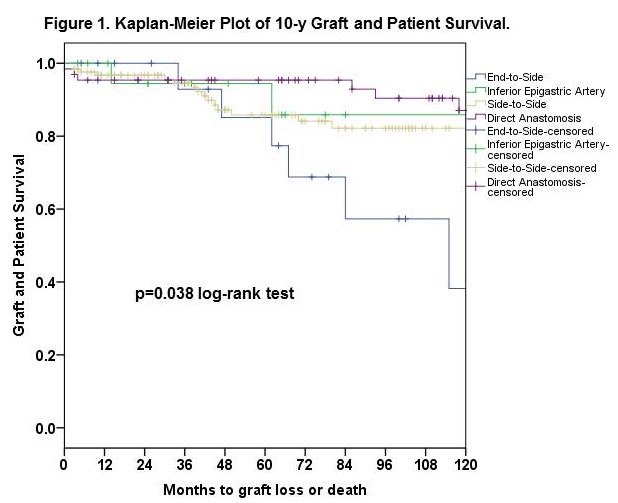Inferior 10-Year Graft and Patient Survival After End-to-Side Reconstruction for Two Renal Arteries in Living Donor Renal Transplantation.
1Department of Surgery, UCSF, San Francisco, CA
2Department of General Surgery, Japanese Red Cross Kumamoto Hospital, Kumamoto, Japan
3Department of Renal Transplant Surgery, Aichi Medical University School of Medicine, Nagakute, Aichi, Japan
4Department of Transplant Surgery, UMass Memorial Medical Center, Worcester, MA
Meeting: 2017 American Transplant Congress
Abstract number: D272
Keywords: Kidney transplantation, Renal artery stenosis, Surgical complications, Survival
Session Information
Session Name: Poster Session D: Long Term Kidney Outcomes
Session Type: Poster Session
Date: Tuesday, May 2, 2017
Session Time: 6:00pm-7:00pm
 Presentation Time: 6:00pm-7:00pm
Presentation Time: 6:00pm-7:00pm
Location: Hall D1
Purpose: Living donor kidneys with two arteries can be revascularized using various techniques depending on anatomy and surgeon preference. We hypothesized that the revascularization technique could impact on the long-term outcomes.
Materials and Methods: We analyzed 1749 living donor renal transplantations performed at our institution between 1999 and 2015. First, we divided the cases into 4 groups: 1 artery (n=1405), 2 arteries with revascularization (n=233), 2 arteries with ligation (n=81) and ≥3 arteries (n=30), and compared the overall outcomes. Second, we subdivided the kidneys with 2 arteries and revascularization (n=230, 3 vascular graft cases were excluded) into 4 groups: end-to-side (ES, n=18), inferior epigastric artery (IEA, n=21), side-to-side (SS, n=126) and direct anastomosis (DA, n=65), and compared outcomes. Kaplan-Meier and log-rank tests were used for analysis.
Results: Ten-year graft and patient survival (GPS) rates were similar for the 4 main groups (p=0.79). In the subgroup analysis, 1y/5y GPS were similar among the 4 groups (1y p=0.63; 5y p=0.38), while SS and DA groups each had 2 immediate graft losses due to thrombosis but ES and IEA had none. However, ES showed the worst 10y GPS (ES: 38.2%, IEA: 85.9%, SS: 82.2% and DA: 87.1%, p=0.038, figure 1).  Notably, 50% of graft loss in ES was due to non-rejection (e.g. secondary focal segmental glomerulosclerosis).
Notably, 50% of graft loss in ES was due to non-rejection (e.g. secondary focal segmental glomerulosclerosis).
Conclusion: The ES technique had equivalent short-/medium-term GPS but markedly shortened 10y GPS. Thus, we conclude that alternative techniques to ES be used for accessory arteries that require revascularization.
CITATION INFORMATION: Yamanaga S, Posselt A, Freise C, Niemann C, Rosario A, Fernandez D, Kobayashi T, Ahearn A, Tavakol M, Kang S.-M. Inferior 10-Year Graft and Patient Survival After End-to-Side Reconstruction for Two Renal Arteries in Living Donor Renal Transplantation. Am J Transplant. 2017;17 (suppl 3).
To cite this abstract in AMA style:
Yamanaga S, Posselt A, Freise C, Niemann C, Rosario A, Fernandez D, Kobayashi T, Ahearn A, Tavakol M, Kang S-M. Inferior 10-Year Graft and Patient Survival After End-to-Side Reconstruction for Two Renal Arteries in Living Donor Renal Transplantation. [abstract]. Am J Transplant. 2017; 17 (suppl 3). https://atcmeetingabstracts.com/abstract/inferior-10-year-graft-and-patient-survival-after-end-to-side-reconstruction-for-two-renal-arteries-in-living-donor-renal-transplantation/. Accessed December 17, 2025.« Back to 2017 American Transplant Congress
